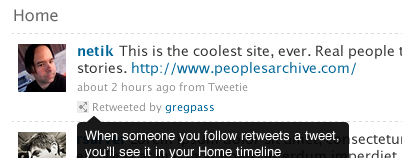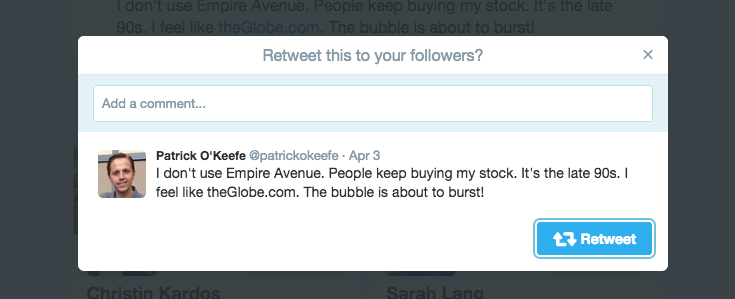Ending the Retweet Debate
 Yesterday Twitter began rolling out a small but crucial change to its retweet functionality, one that allows users to add comments to the tweets they retweet to their followers.
Yesterday Twitter began rolling out a small but crucial change to its retweet functionality, one that allows users to add comments to the tweets they retweet to their followers.
The idea was actually first tested last summer but never saw wide release. Now, however, it appears to be rolling live to all users that are on the Twitter site or using the iPhone app. Other platforms, including Android, are expected to be updated soon and it’s expected to be added to the API, meaning third-party apps will be able to use it as well.
But while the change may be a small one to the users, it’s potentially a major one for attribution on Twitter. By effectively eliminating the “manual retweet”, Twitter is ending the great retweet debate that has roared for years and is making attribution even more the norm on the service.
To understand why, we have to first look at the history of the retweet and how this change is significant.
The History of the Retweet
The idea of the retweet didn’t originate from Twitter, but rather, it’s users. In the early days of the site, Twitter users developed a code by which they would repost or retweet the tweets of others and it worked like this:
RT @originalusername ORIGINALTWEET
This created serious problems because of Twitter’s character limit. If the original tweet was 139 characters long, the RT would be longer than the 140 character limit. So a similar system was designed to introduce “Modified Tweets”, which worked like this:
MT @originalusername MODIFIEDTWEET
The goal of modified tweets were to alter the original message to be under the (new) character limit, but not change the message in any way.
This approach was largely codified into Twitter and the various apps that build upon it. However, in 2009 Twitter launched the first major change to the way it handles retweets by introducing truly verbatim retweets.

The idea was straightforward. Rather than a using a code-based system, Twitter would now simply push the tweet to your followers verbatim, including the image and name of the original poster, with only a small note saying it was retweeted by you.
This eliminated most of the need for both the RT and the MT system, which then became known as manual retweets. Manual retweets were replaced functionally by just clicking the retweet button and modified tweets weren’t necessary because there was no way the retweet would be longer than the original, meaning no editing was necessary.
The exception was in cases where a user wanted to add a comment to a retweet, for example, to note that they are sharing but do not agree with/approve of a tweet.
But despite this limited use, the manual tweet system did not go away. Many users still preferred to use it, leading to allegations that manual retweets were more about self-promotion than actual sharing.
Many users protested this, saying that there were still circumstances where manual retweets were necessary, especially when they wanted to offer commentary on a tweet. This led to a debate about when (and if) it was acceptable to use a manual retweet that has raged for years.
However, that debate is now moot as the manual retweet should be dead or dying. But, that’s only the case if the new system is truly a superior replacement.
How the New System Works
The change to the retweet function is extremely simple. Whether you are using the Twitter app or the website, when you click the retweet button you are given the option to add a comment to the tweet you’re sending out.

Once you do so, your message will appear in your feed with the tweet you’re retweeting appearing below, like this:

Note: This was just an example I found in my Twitter stream, not attempting to endorse or comment on these tweets, just showcase the functionality.
With this system, there is room for your comment, the original tweet and all of the attribution information at the same time. The only caveat is that the retweet comment can only be 116 characters long, which is required to leave enough room for the Twitter URL that creates the embed.
As a result, there is nothing you can do with a manual retweet that can’t be done within Twitter’s retweet system. The archaic manual tweet system should be retired once this system makes it across all platforms and apps (including Tweetdeck and third-party apps).
However, as Facebook has shown us, that may not happen if it doesn’t help user gain the edge they seek.
Greed and Social Media
As we discussed last week when looking at the Facebook video piracy controversy, if there is a benefit to doing something on social media, some will do it, no matter how much extra work or unscrupulous it is.
So this begs the simple question: Does manual retweeting have an advantage over the new Twitter system?
The main advantages of the manual retweet system were that
- Retweets of the retweet would be attributed to the retweeter, not the original poster.
- The retweeter was featured more prominently than the original poster.
- There was an opportunity to comment or expand on the original tweet.
The new system fulfills all three of those functions pretty neatly.
First, the retweeter gets any credit for their comment if their retweet is picked up. Second, as you can see in the screenshot above, the retweeter, if he or she adds a comment, is now featured much more prominently than the original poster, who doesn’t even get an icon and is positioned below the new content. Finally, the ability to add a comment is the core function of the new retweet system.
The result is that manual retweets offer little, if any, benefit over the new system. Those who will retweet and share with whatever system gives them the biggest boost will likely choose the new system, further bolstered by the fact that it is more visually striking and stands out more than manual retweets.
This, in turn, is how Twitter is ending the retweet debate, not by eliminating or banning manual retweets, but by providing an alternative that eliminates the benefit of them. Once this system goes fully live, those still using manual retweets won’t be doing so out of greed, but out of ignorance and habit.
Twitter is ending the retweet debate and that’s good news for everyone.
Bottom Line
To be clear, the new retweet system isn’t perfect. It would be nice if the original tweet/user was given more attention and visual focus. The lack of an icon and the prominence of the retweet comment causes the original content to be dwarfed more than a little bit.
That being said, it’s still far better than the existing alternative. Manual retweets with comments had no icons and did even less to highlight the original tweet and the original user.
So while it’s not perfect, it works out better for everyone and there are opportunities to hone and improve it down the road.
All in all, this is an excellent example how social networks can encourage and reward proper attribution, by providing the tools to do it, making them easy to use and making them worth using.
Hopefully this will be the end of the retweet debate and we can get back to enjoying and using Twitter as it was meant to be used.
Want to Reuse or Republish this Content?
If you want to feature this article in your site, classroom or elsewhere, just let us know! We usually grant permission within 24 hours.
